WASHINGTON — President Donald Trump has signed an executive order directing federal agencies to scale back regulations on domestic commercial fishing and develop new trade and supply chain strategies aimed at increasing the competitiveness of U.S.-harvested seafood.
The order, titled “Restoring American Seafood Competitiveness”, claims that nearly 90 percent of seafood sold in the United States is currently imported.
Trump has directed the Department of Commerce to evaluate and potentially suspend or revise fishery-specific rules that “overly burden” the fishing, aquaculture, and processing sectors. The Department of Commerce, in consultation with the Department of Health and Human Services and other agencies, is also tasked with improving fisheries science and modernizing data systems.
Another component of the order includes a directive to develop an “America First Seafood Strategy,” in coordination with the Department of Agriculture, to enhance domestic processing capacity, increase seafood purchases in nutrition programs and promote the health benefits of seafood to U.S. consumers.
On trade, the order requires the U.S. Trade Representative to examine trade practices of major seafood-producing countries—particularly in relation to illegal, unreported, and unregulated IUU fishing and the use of forced labor.
The executive order also instructs agencies to review recent expansions of the Seafood Import Monitoring Program and consider tightening enforcement against high-risk shipments from nations that violate international fishing standards.
Within 180 days, the Secretary of Commerce and the Secretary of the Interior must review existing marine national monuments and advise the president on whether any should be opened to commercial fishing, consistent with preserving historic and scientific resources.
According to the Associated Press, some environmental groups cited the importance of relying on the Magnuson-Stevens Fishery Conservation and Management Act, which has guided U.S. fishery management for nearly 50 years and was intended to combat overfishing. The number of fish stocks on the federal overfished list grew from 40 in 2013 to 47 in 2023; conservationists said they fear that number will grow with weakened regulations.








